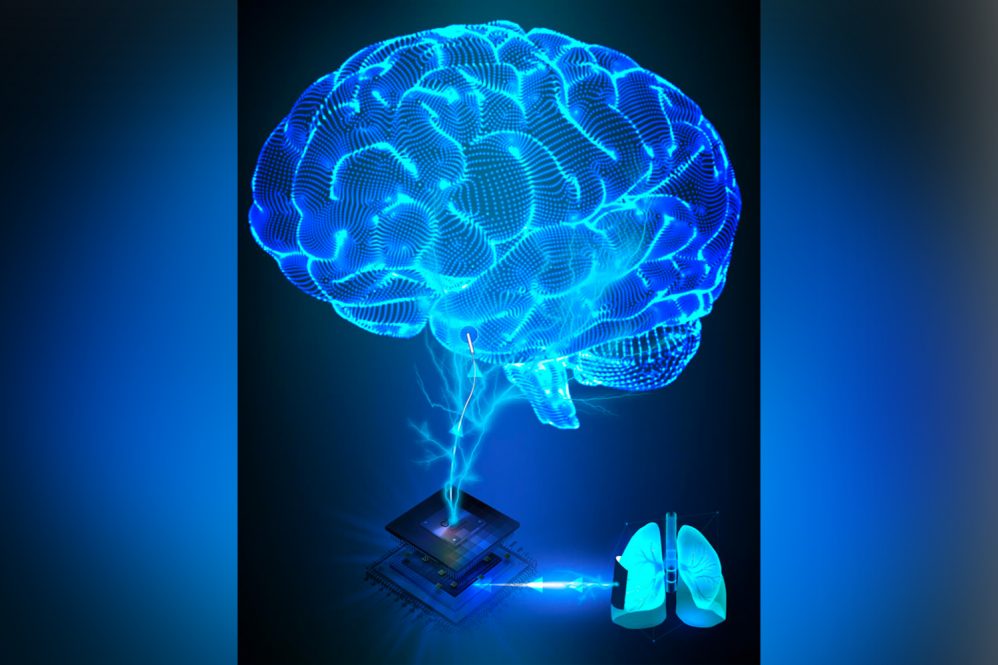
UConn researchers have developed a way of charging deep brain stimulators that don't require the battery power that's currently standard (Contributed Illustration).
Implantable deep brain stimulators can help many people with neurological and psychiatric disease when traditional treatments fail. But surgery every time the batteries need to be changed is a major drawback. Now, UConn researchers report in Cell Reports Physical Sciences on Oct. 11
Deep brain stimulators are becoming more common, with about 150,000 new devices implanted each year. They are normally placed under the skin in the chest area and their electrodes implanted within the brain. The electrodes zap the brain with electrical pulses multiple times per second to regulate the brain’s abnormal electrical activity. Deep brain stimulators can help people with Parkinson’s disease and other movement disorders to regain control over their muscle motions. Research has also shown the technique can significantly reduce the symptoms for psychiatric conditions such as treatment-resistant depression and obsessive-compulsive disorder.
Just like a pacemaker, deep brain stimulators are battery powered. While most pacemaker batteries last from 7-10 years, deep brain stimulator batteries typically require changing every 2-3 years because of their high energy consumption. And each battery change requires surgery.
UConn chemists Esraa Elsanadidy, Islam Mosa, James Rusling, and their collaborators have developed a deep brain stimulator that never needs its batteries changed.
Instead of a battery, the new device converts the motion of the user’s chest as they breathe into electricity. As the person breathes in and out, the chest wall presses on a very small and thin electric generator, called a triboelectric nanogenerator. The nanogenerator converts that movement into static electricity. The concept is akin to rubbing a balloon on your shirt and then putting it on a wall to stick there. The wall and the balloon have different static electric charges and stick to each other. Charges from the more negative material stick to the more positive one, and in the deep brain stimulator’s triboelectric nanogenerator, this creates a current that charges a supercapacitor. The supercapacitor discharges the electricity to power the medical device and stimulate the brain.
“We created our triboelectric nanogenerator using new nanomaterials which produce significant energy output when they come in contact with each other, enough energy to run the deep brain stimulator,” says Elsanadidy.
“We wanted to make this fit in with the rest of the available technology in the usual way. In principle, if someone already has a deep brain stimulator, we could just replace the battery with this generator without having to retrofit them with a wholly new device,” says UConn chemist Jim Rusling.
The team tested the device by embedding their triboelectric nanogenerator in the chest of a simulated pig containing a pig lung connected to a pump. When the pig’s lung is inflated and deflated during the inhalation and exhalation, it pushes against the nanogenerator, causing two layers inside the nanogenerator to rub, and produce electricity. The electricity travels through a thin wire to charge the supercapacitor which powers the deep brain stimulator electronics placed outside the rib cage. The brain stimulator used the electricity stored in the supercapacitor to create pulses 60 times a second, just as it would in a commercial device.
“This is the first system that combines all the pieces; efficient energy harvesting, energy storage and the controlled brain stimulator. We demonstrated that our self-sustainable deep brain stimulator can intermittently stimulate the brain tissue by alternating periods of stimulation and periods of no stimulation which is an effective deep brain stimulation approach for treating psychiatric conditions,” says Mosa, who is also the chief technology officer of VoltXon, a company in UConn’s Technology Incubator Program that is commercializing the system. The next step will be to try the device in a large animal.
Kim Krieger
today.uconn.edu


